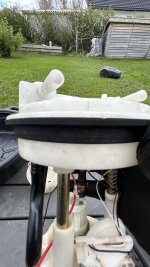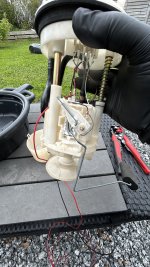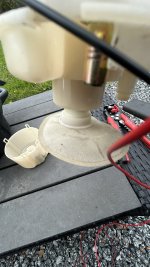Hi! I have problem with the fuel pump, or it is some sort of leak that makes the pump work harder than before. To fix gasoline fume in the car, I ordered a new gasket for the pump. Used OEM number: 7743530. This gasket did not looked the same as the one I took off. The new one was wider, 21 mm. But it fitted nicely on. The problem is the sound of the pump, it now makes high frequency noise when the engine is running. The pump starts okey, it starts and stop before I turn the engine on. Then it makes the noise that I haven’t heard before.
I have looked over the fuel lines, but no leakage as I can see. I have measured the pressure out from the pump, and it is 2,5 bar.
The car starts and is running normal at 1000 rpm.
When I take it on the road, and I try to give some more throttle, and that is just over 3000 rpm, it will stall. Like it is lacking fuel.
So, I have now changed back to the old gasket, but it is still the same issue at 3000 rpm and the same noise.
Is it something that I could have missed at the assembly, that make the pump not work correctly, or is the pump itself that is broken?
How can I rule out something in this equation? Is it possible to check the pump itself, taking it out and put some 12 Volt on, and let it pump in water? I know it will work, because I have checked the return line as well.
Anyone experienced the same and can give me a hint on what is wrong. The car was running fine before I change the gasket, and that rules out the filter etc.
Is it possible to assembly the pump wrong, the arrow is pointing more or less the same way I remember it to be. I tried to be as gentle as I could, and I just don’t get how this could suddenly be broken.
The car is Fiat Barchetta, 97.
I have looked over the fuel lines, but no leakage as I can see. I have measured the pressure out from the pump, and it is 2,5 bar.
The car starts and is running normal at 1000 rpm.
When I take it on the road, and I try to give some more throttle, and that is just over 3000 rpm, it will stall. Like it is lacking fuel.
So, I have now changed back to the old gasket, but it is still the same issue at 3000 rpm and the same noise.
Is it something that I could have missed at the assembly, that make the pump not work correctly, or is the pump itself that is broken?
How can I rule out something in this equation? Is it possible to check the pump itself, taking it out and put some 12 Volt on, and let it pump in water? I know it will work, because I have checked the return line as well.
Anyone experienced the same and can give me a hint on what is wrong. The car was running fine before I change the gasket, and that rules out the filter etc.
Is it possible to assembly the pump wrong, the arrow is pointing more or less the same way I remember it to be. I tried to be as gentle as I could, and I just don’t get how this could suddenly be broken.
The car is Fiat Barchetta, 97.





